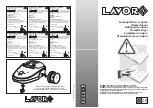
Operation
Once the system is properly installed and all personnel are clear of the high voltage tubes, the system
can be turned on:
DO NOT TOUCH TUBE
1. Ensure the ionization power knob is turned all the to the appropriate quadrant. From low to high
clockwise.
2. Plug the power cord into the plug receptacle on the FC-400 ionization system.
3. Turn the system on and set the ionization power knob to the appropriate setting Low, Med, High.
The green embedded LED light left of the power knob should light up to indicate that the system is on,
ionization has been activated, and high voltage is being sent to the tube.
4. Settings are determined upon commissioning and installation with the Criteria below:
The system is intended to deliver ions into the treated area such that the ion levels should increase by
350 up to 1500 negative ions / cm3. The desired ion increase is dependent on many factors, including
space, use, contaminant level, humidity RH and distribution effectiveness. An authorized AtmosAir
design consultant should recommend the desired ion increase and appropriate system layout.
!!!CAUTION!!!
A non-functioning LED light may improperly indicate that the system is not functioning. Be sure to
disconnect quick disconnect power before performing maintenance or troubleshooting the system.
!!!CAUTION!!!
Maintenance Requirements
The maintenance requirements on an AtmosAir system are mainly site- dependent. The FC-400 series
is designed for automatic operation and replacement of tube at 2 years 8,800 hours of long life. Once
commissioned, maintenance is minimal. A tube inspection is recommended at one year & in general,
bi-annual maintenance is recommended along with a tube replacement at a minimum of every two years.
The FC-400 series is provided with an internal fuse and a spare fuse is provided. The local AtmosAir
dealer can provide you with an annual service contract.
Quarterly / Bi-annual Maintenance Requirements:
•
Visually check the performance of the system by checking the green light on the individual units. If
the light is on, and you can hear the ‘buzz’ of the tubes, then unit is functioning properly. If not, proceed
to the troubleshooting section for repair. Maintain a physical distance between all personnel and the
tubes while system is operating or turned on.



























